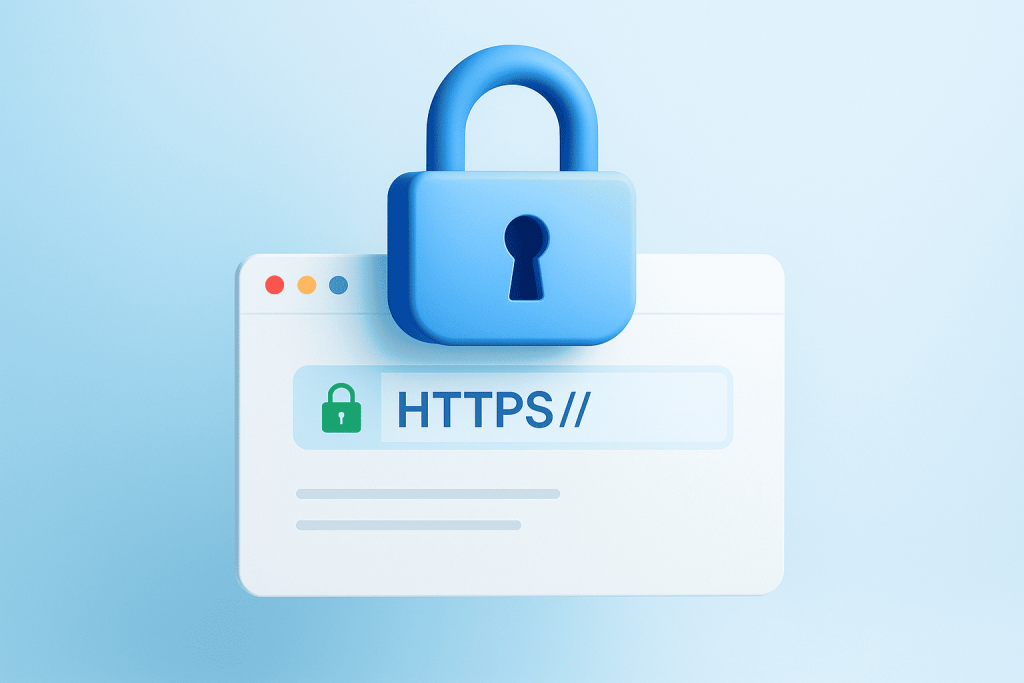
In an era when cyber threats are becoming increasingly sophisticated, protecting user data is not an additional option, but a mandatory requirement for any website. One of the key tools that ensures online security is an SSL certificate. It is responsible for data encryption, protects against interception of information and increases trust in the resource. But how to choose the right certificate? Let’s figure out how the different types differ, why HTTPS is important for every project and how to easily enable protection via RX-NAME.
What SSL Is and Why It Matters
SSL (Secure Sockets Layer) is a protocol that ensures the secure transmission of data between a user and a server. Today, its improved version TLS is more commonly used, but in everyday language people still say “SSL certificate.” It encrypts traffic, protecting logins, passwords, payment details, and any other confidential information from interception.
A site with SSL opens via the HTTPS protocol, and a padlock icon appears next to the address in the browser. This is not only a security element but also an important signal for search engines: Google and other search engines take HTTPS into account as a ranking factor. In addition, modern browsers label sites without a certificate as “Not Secure,” which instantly lowers visitor trust.
Why Your Project Needs SSL
Data security — protection against interception of passwords, card numbers, and other personal information.
SEO positions — sites with HTTPS get an advantage in search results.
User trust — the padlock icon increases conversion rates.
Integrations — many payment systems and APIs work only over a secure connection.
If you rent a VPS or use server colocation, an SSL certificate becomes a mandatory element of the basic infrastructure.
Types of SSL Certificates: DV and OV
DV (Domain Validation) — a certificate with domain validation.
The verification process is quick: it confirms that you own the domain (via e-mail, DNS, or a file on the site). This is an inexpensive option suitable for blogs, personal websites, and small online stores.
OV (Organization Validation) — a certificate with organization validation.
Here, in addition to the domain, the legal entity is verified: registration documents, contact details. The certificate will include the company name, which increases trust — especially important for online stores, banks, and large projects.
There is also EV (Extended Validation) — with extended verification and a green bar in the browser, but in 2025 this visual effect is almost no longer used, although the certificate still provides the maximum level of trust.
How to Get SSL Through RX-NAME: Quickly and Without a Terminal
Choose a certificate — the SSL certificates page lists all options (DV, OV, and others).
Place an order — choose the validity period (usually 1 year).
Confirm domain ownership — via e-mail, DNS record, or uploading a file to the site root.
Install the certificate — through the hosting or VPS control panel. If the site is hosted on RX-NAME servers, installation is free.
Thus, even without a command line and complex instructions, you can activate HTTPS literally within an hour.
HTTPS and SEO: Direct Connection
Search algorithms take website security into account. If your project runs over HTTP, it risks:
losing positions in search results;
receiving a “Not Secure” warning in the browser;
lowering user trust rates.
Switching to HTTPS also improves behavioral metrics: users stay on the site longer, perform more target actions, and leave payment pages less frequently.
How to Choose a Certificate for Your Project
Personal website, blog, small online store — DV. Fast, inexpensive, simple.
Company, brand, B2B platform — OV. Increases trust, especially when working with partners and government agencies.
Large e-commerce, bank, financial organization — OV or EV, depending on regulatory requirements.
If you use colocation or rent a server, it’s better to plan for OV right away to emphasize the status and official nature of the resource.
Mistakes to Avoid
Lack of auto-renewal — the certificate may expire, and the site will get a “Not Secure” warning.
Choosing a free certificate without considering limitations — for example, Let’s Encrypt is not suitable for all integrations.
No HTTPS on all subdomains — if the main domain has a certificate but the subdomains don’t, users will still receive a warning.
SSL Installation and Support at RX-NAME
RX-NAME offers a full cycle: selection, issuance, installation, and renewal reminders.
For clients on VPS or dedicated servers, specialist assistance is available for SSL integration in complex projects: with load balancers, CDN, and microservice architecture.
Conclusion
An SSL certificate is not just a “padlock” in the address bar but a basic element of reputation, security, and growth. Through RX-NAME, you can choose and install the right certificate without technical difficulties, giving your website protection and a competitive edge.

Leave a Reply